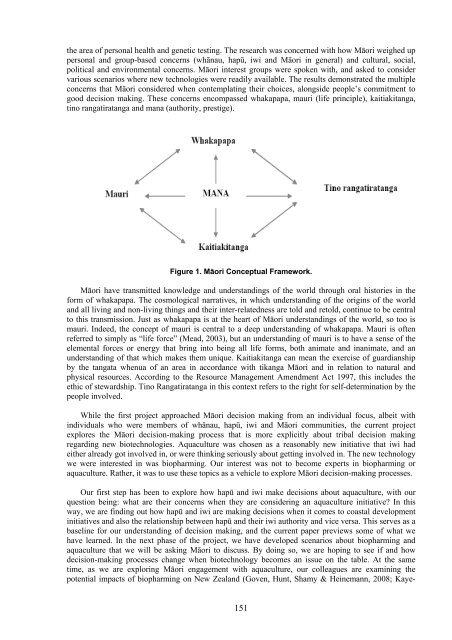traditional knowledge conference 2008 te tatau pounamu
traditional knowledge conference 2008 te tatau pounamu
traditional knowledge conference 2008 te tatau pounamu
Create successful ePaper yourself
Turn your PDF publications into a flip-book with our unique Google optimized e-Paper software.
the area of personal health and genetic <strong>te</strong>sting. The research was concerned with how Māori weighed uppersonal and group-based concerns (whānau, hapū, iwi and Māori in general) and cultural, social,political and environmental concerns. Māori in<strong>te</strong>rest groups were spoken with, and asked to considervarious scenarios where new <strong>te</strong>chnologies were readily available. The results demonstra<strong>te</strong>d the multipleconcerns that Māori considered when con<strong>te</strong>mplating their choices, alongside people’s commitment togood decision making. These concerns encompassed whakapapa, mauri (life principle), kaitiakitanga,tino rangatiratanga and mana (authority, prestige).Figure 1. Māori Conceptual Framework.Māori have transmit<strong>te</strong>d <strong>knowledge</strong> and understandings of the world through oral histories in theform of whakapapa. The cosmological narratives, in which understanding of the origins of the worldand all living and non-living things and their in<strong>te</strong>r-rela<strong>te</strong>dness are told and retold, continue to be centralto this transmission. Just as whakapapa is at the heart of Māori understandings of the world, so too ismauri. Indeed, the concept of mauri is central to a deep understanding of whakapapa. Mauri is of<strong>te</strong>nreferred to simply as “life force” (Mead, 2003), but an understanding of mauri is to have a sense of theelemental forces or energy that bring into being all life forms, both anima<strong>te</strong> and inanima<strong>te</strong>, and anunderstanding of that which makes them unique. Kaitiakitanga can mean the exercise of guardianshipby the tangata whenua of an area in accordance with tikanga Māori and in relation to natural andphysical resources. According to the Resource Management Amendment Act 1997, this includes theethic of s<strong>te</strong>wardship. Tino Rangatiratanga in this con<strong>te</strong>xt refers to the right for self-de<strong>te</strong>rmination by thepeople involved.While the first project approached Māori decision making from an individual focus, albeit withindividuals who were members of whānau, hapū, iwi and Māori communities, the current projec<strong>te</strong>xplores the Māori decision-making process that is more explicitly about tribal decision makingregarding new bio<strong>te</strong>chnologies. Aquaculture was chosen as a reasonably new initiative that iwi hadeither already got involved in, or were thinking seriously about getting involved in. The new <strong>te</strong>chnologywe were in<strong>te</strong>res<strong>te</strong>d in was biopharming. Our in<strong>te</strong>rest was not to become experts in biopharming oraquaculture. Rather, it was to use these topics as a vehicle to explore Māori decision-making processes.Our first s<strong>te</strong>p has been to explore how hapū and iwi make decisions about aquaculture, with ourquestion being: what are their concerns when they are considering an aquaculture initiative? In thisway, we are finding out how hapū and iwi are making decisions when it comes to coastal developmentinitiatives and also the relationship between hapū and their iwi authority and vice versa. This serves as abaseline for our understanding of decision making, and the current paper previews some of what wehave learned. In the next phase of the project, we have developed scenarios about biopharming andaquaculture that we will be asking Māori to discuss. By doing so, we are hoping to see if and howdecision-making processes change when bio<strong>te</strong>chnology becomes an issue on the table. At the sametime, as we are exploring Māori engagement with aquaculture, our colleagues are examining thepo<strong>te</strong>ntial impacts of biopharming on New Zealand (Goven, Hunt, Shamy & Heinemann, <strong>2008</strong>; Kaye-151
















